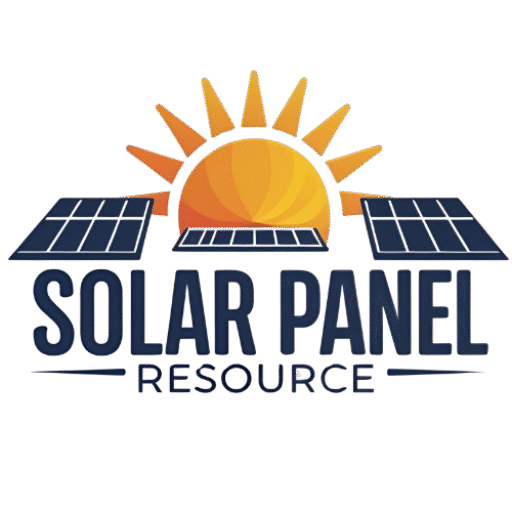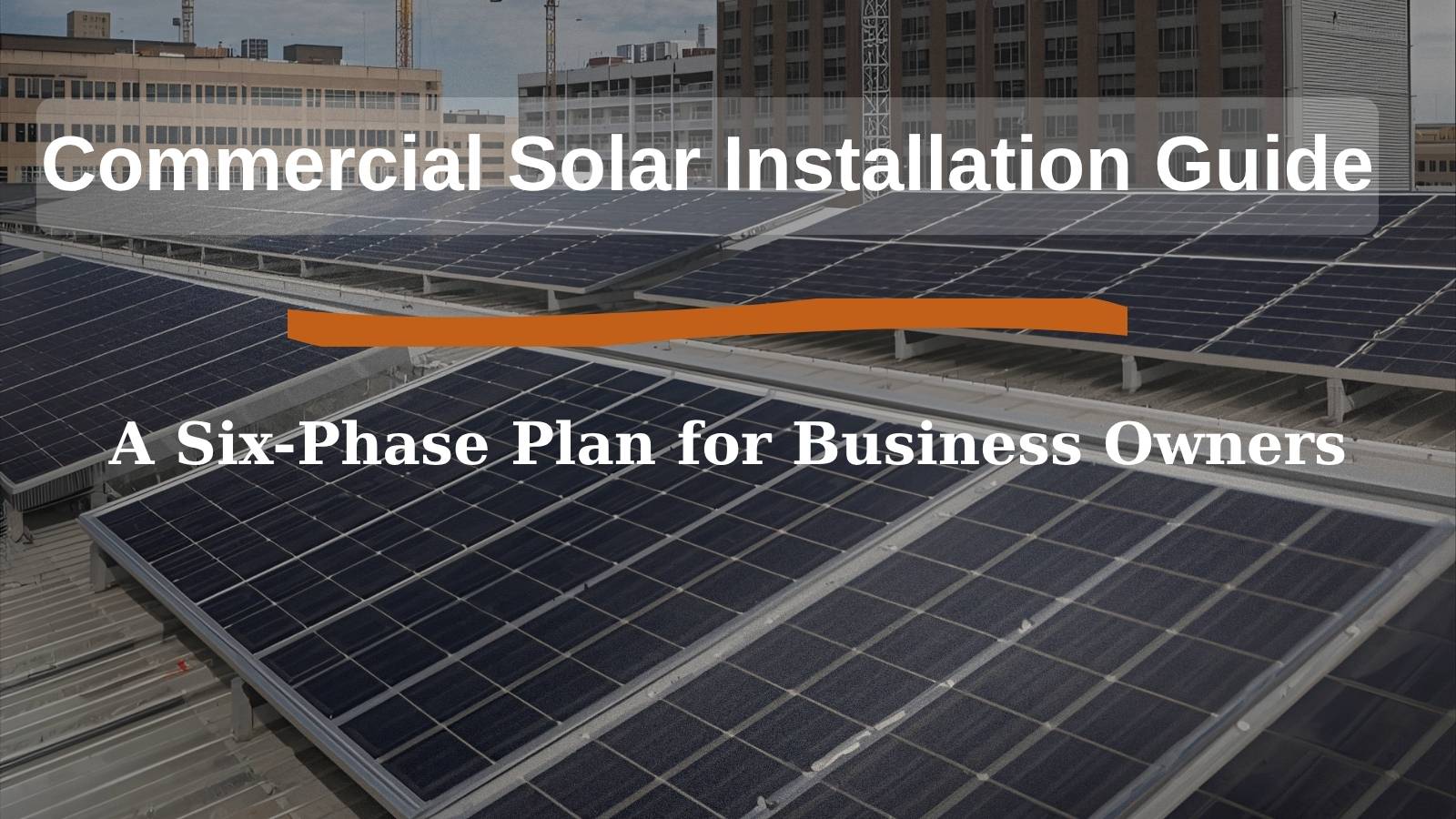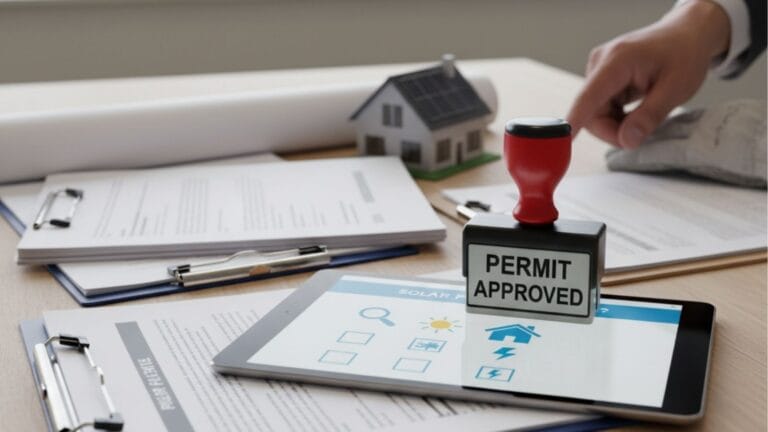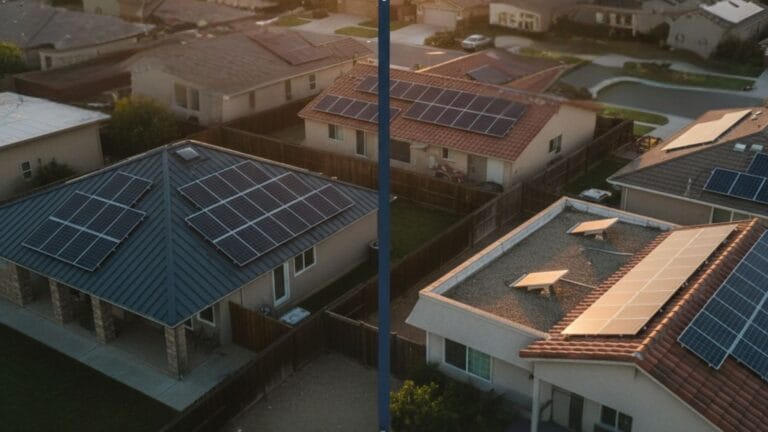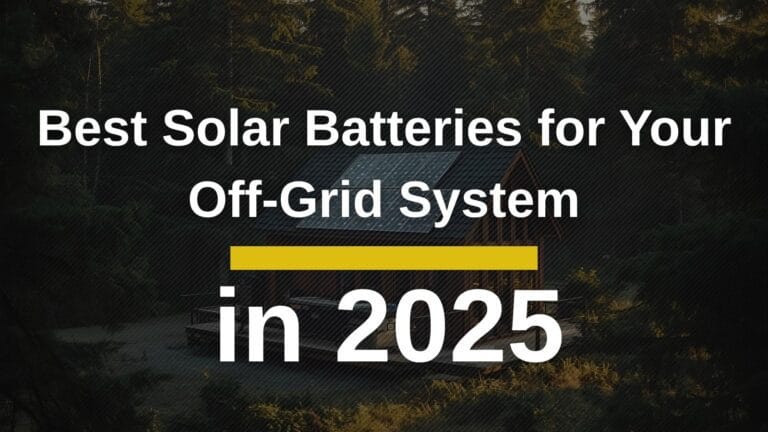Commercial Solar Installation Guide: A Six-Phase Plan for Business Owners
For business owners today, navigating the complexities of operational costs, environmental responsibility, and energy resilience is a constant challenge. As electricity prices fluctuate and consumer demand for sustainable practices grows, many are turning to a powerful, forward-thinking solution: solar energy. A commercial solar installation isn’t just about placing panels on a roof; it’s a strategic business decision that can slash overhead, stabilize budgets, and significantly boost your brand’s reputation. However, the path from consideration to a fully operational solar array can seem daunting.
This comprehensive commercial solar installation guide demystifies the entire process. We’ve broken it down into a clear, actionable six-phase plan designed specifically for business owners. Whether you manage a small retail space, a large warehouse, or an entire manufacturing facility, this guide will provide the expert insights you need to make an informed decision and successfully transition your business to clean, renewable energy.
Why Businesses Are Switching to Solar Energy
Before diving into the “how,” it’s crucial to understand the “why.” The move towards solar for business is driven by a powerful convergence of financial incentives, operational benefits, and corporate responsibility. It’s a multifaceted investment that pays dividends long after the initial setup.
Financial Benefits: ROI and Incentives
The most compelling reason for many businesses is the significant return on investment (ROI). A commercial solar panel system is a power plant on your property, generating electricity that directly offsets your utility bills. This leads to immediate and substantial monthly savings.
- Reduced Operating Costs: Electricity is often one of the largest variable expenses for a company. Solar energy drastically reduces or even eliminates this cost, freeing up capital for other business investments.
- Hedge Against Inflation: Utility electricity rates are notoriously unpredictable and tend to rise over time. Solar locks in your energy costs for the 25+ year lifespan of the system, providing long-term budget certainty.
- Lucrative Incentives: Governments around the world offer powerful financial incentives to encourage solar adoption. In the U.S., for example, the Investment Tax Credit (ITC) allows businesses to deduct a significant percentage of the cost of their solar installation from their federal taxes. Paired with accelerated depreciation (MACRS), the financial benefits are substantial.
Operational Resilience and Energy Independence
Power outages can cripple business operations, leading to lost revenue, decreased productivity, and data loss. By pairing a commercial solar panel installation with battery storage, businesses can achieve a new level of energy independence. During a grid outage, your solar and storage system can keep critical operations—like servers, lights, and refrigeration—running smoothly, providing a major competitive advantage.
Enhancing Your Brand’s ESG Profile
In today’s market, consumers and investors alike are prioritizing companies with strong Environmental, Social, and Governance (ESG) credentials. Installing solar is a visible and powerful statement of your company’s commitment to sustainability. It can enhance your brand image, attract environmentally conscious customers, and improve employee morale.
The Six-Phase Plan for a Successful Commercial Solar Installation
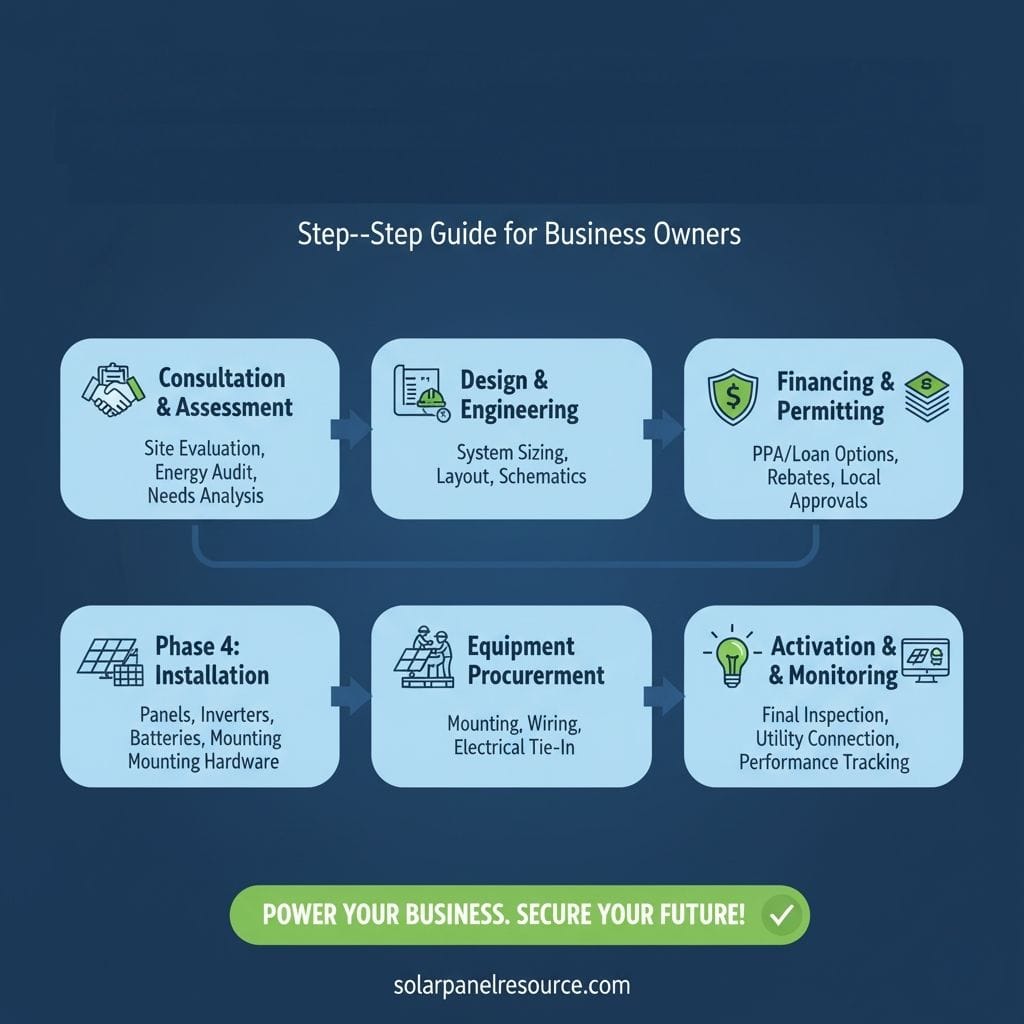
A well-executed project follows a structured, logical progression. Our six-phase plan ensures that every detail is covered, from the initial idea to long-term operation, maximizing your investment and minimizing disruption to your business.
Phase 1: Initial Consultation and Feasibility Study
This foundational phase is all about discovery and data. It’s where you and your potential solar partner determine if solar is a viable and profitable solution for your specific circumstances.
Defining Your Energy Goals
What do you want to achieve with solar? Your goals will shape the entire project. Are you aiming to offset 100% of your electricity consumption, reduce peak demand charges, ensure backup power for critical loads, or simply make a tangible commitment to sustainability? Clearly defining these objectives from the outset is key.
Preliminary Site Assessment
A solar professional will conduct a preliminary assessment of your property. This involves evaluating your building’s roof (or available land) for factors like:
- Space: Is there enough unshaded area to accommodate the number of panels needed?
- Orientation and Tilt: South-facing roofs (in the Northern Hemisphere) are ideal, but east-west orientations can also be highly effective.
- Structural Integrity: Can the roof support the weight of a solar array?
- Shading: Are there nearby trees, buildings, or other obstructions that could cast shadows on the panels and reduce output?
Understanding Your Energy Consumption
To design an appropriately sized system, you must understand how and when your business uses electricity. This requires analyzing at least 12-24 months of your utility bills. Your solar consultant will look at your total consumption (in kilowatt-hours, kWh) and your peak demand (in kilowatts, kW) to create a detailed energy usage profile.
Phase 2: System Design and Engineering
With the data from Phase 1, engineers can now design a custom photovoltaic (PV) system tailored to your property and goals. This is where the project begins to take tangible shape.
Detailed Site Survey and Structural Analysis
A technical team will visit your site to take precise measurements and conduct a thorough structural analysis of your roof. An electrical engineer will assess your existing electrical infrastructure—including panels, transformers, and switchgear—to ensure it can handle the integration of a solar power system. This step is critical for safety and performance.
Choosing the Right Solar Technology
Not all solar equipment is created equal. Your designer will help you select the best components for your needs, balancing cost, efficiency, and warranties. Key components include:
- Solar Panels (Modules): Monocrystalline panels are generally more efficient and perform better in limited space, while polycrystalline panels can be a more budget-friendly option.
- Inverters: These are the brains of the system, converting the DC electricity generated by the panels into AC electricity your business can use. Options include string inverters, microinverters, or DC power optimizers.
- Racking and Mounting: This is the framework that secures the panels to your roof or the ground. It must be engineered to withstand local wind and snow loads.
Finalizing the System Design and Production Estimates
Using specialized software, the engineering team will create a final system design, including detailed electrical diagrams and construction plans. They will also provide a precise estimate of how much energy the system will produce annually, often backed by a performance guarantee.
Phase 3: Financing, Incentives, and Permitting
This phase handles the critical financial and administrative hurdles that must be cleared before any physical work can begin. Navigating this landscape correctly is essential for maximizing the financial success of your business solar installation.
Exploring Financing Options: Leases, PPAs, and Loans
Few businesses pay for a commercial solar project with cash. Fortunately, several financing options are available:
- Solar Loan: You borrow money to purchase the system outright. You own the system and receive all tax credits and incentives directly.
- Solar Lease: You pay a fixed monthly fee to a third party that owns and maintains the system on your property. This often requires little to no upfront capital.
- Power Purchase Agreement (PPA): Similar to a lease, a third party owns the system. However, instead of a fixed monthly fee, you agree to purchase the electricity generated by the system at a set, often discounted, rate per kWh.
Navigating Federal, State, and Local Incentives
Your solar installer should be an expert in identifying and applying for all available incentives. This complex web can include federal tax credits, state-level rebates, performance-based incentives (PBIs), and local grants. According to the Solar Energy Industries Association (SEIA), a leading national trade association, these incentives can significantly reduce the net cost of a commercial solar installation. For more information on federal policies, you can visit governmental resources like the U.S. Department of Energy’s Solar Energy Technologies Office.
The Permitting and Approval Process
Before construction can start, the system plans must be submitted to your local municipality for building and electrical permits. This process ensures the design complies with all local building codes, safety regulations, and zoning laws. Your installer will manage this entire process, which can take several weeks or even months depending on the jurisdiction.
Phase 4: Procurement and Installation
With permits in hand, the project moves from paper to reality. This is the construction phase where your solar array is physically built and installed on your property.
Sourcing High-Quality Components
Your solar installation company will order all the necessary equipment—panels, inverters, racking, and electrical components—from trusted manufacturers. A reputable installer will have strong supply chain relationships to ensure timely delivery of high-quality, warrantied parts.
The Installation Timeline and Process
The installation itself is often the quickest part of the entire process. A dedicated team of certified electricians and installers will work on-site. The process typically involves:
- Staging materials and setting up safety equipment.
- Installing the mounting hardware (racking) on the roof.
- Attaching the solar panels to the racking.
- Running conduit and wiring the panels together.
- Installing the inverters and connecting them to your main electrical service panel.
The duration can range from a few days for a small system to several weeks for a large, complex array.
Safety Protocols and Quality Assurance
Safety is paramount during installation. Your chosen installer must adhere to strict safety protocols to protect both their crew and your property. Throughout the build, a project manager will conduct quality assurance checks to ensure every component is installed to the manufacturer’s specifications and industry best practices.
Phase 5: Interconnection and Commissioning
The system is built, but it can’t be turned on just yet. This phase involves getting formal approval from the utility company and performing final system checks.
Connecting to the Utility Grid (Interconnection)
Your solar system must be safely connected to the public power grid. This requires submitting an interconnection application to your utility company. They will review the project to ensure it meets their technical and safety requirements. They may need to install a new bi-directional meter that can track both the power you draw from the grid and the excess power your system sends back to it (a process known as net metering).
System Testing and Commissioning
Once the utility provides its approval, a process called commissioning begins. Engineers will power up the system for the first time and conduct a series of rigorous tests to verify that every component is working correctly and safely. They will check voltages, currents, and communication systems to ensure the array is performing as designed.
Final Inspections and “Permission to Operate” (PTO)
A final inspection by your local building authority is required to close out the permits. After this inspection is passed and the utility company is satisfied, they will grant official “Permission to Operate” (PTO). Only after receiving PTO can you legally turn on your system and start generating your own clean electricity.
Phase 6: Operations, Maintenance, and Monitoring
Your commercial solar process doesn’t end when the switch is flipped. Proper long-term care ensures your system continues to operate at peak performance for its entire 25-30 year lifespan, maximizing your ROI.
Proactive System Monitoring
Modern solar systems come with sophisticated monitoring software that tracks energy production in real-time. This allows you, and your solar provider, to see how the system is performing down to the individual panel level. The software can automatically flag any performance issues, often before you would notice them, allowing for swift resolution.
Routine Maintenance and Cleaning
Solar panels are remarkably durable and require very little maintenance. However, periodic cleaning to remove dirt, dust, and debris can boost production. An annual or semi-annual inspection is also recommended to check for loose connections, damage, and overall system health. Most solar installers offer Operations & Maintenance (O&M) plans to handle this for you.
Understanding Warranties and Performance Guarantees
Your system comes with multiple warranties. Solar panels typically have a 25-year performance warranty (guaranteeing a certain level of output) and a 10-12 year product warranty. Inverters usually have warranties of 10-25 years. Your installer should also provide a workmanship warranty covering their labor. Understanding these protections provides peace of mind for your long-term investment.
Common Misconceptions About Commercial Solar
Several myths can deter business owners. Let’s clear them up:
- “Solar doesn’t work in cloudy or cold climates.” This is false. Solar panels work on light, not heat, and still produce significant power on overcast days. In fact, some panels are even more efficient at cooler temperatures. Germany, a leader in solar energy, is not known for its sunny climate.
- “Solar panels are fragile and require constant maintenance.” Panels are built to be incredibly durable, engineered to withstand hail, snow, and high winds. As mentioned, maintenance is minimal.
- “The upfront cost is too high.” While the initial investment is significant, the combination of powerful incentives and diverse financing options (like $0-down PPAs) makes solar accessible to businesses of all sizes. The long-term savings almost always outweigh the initial cost.
Choosing the Right Commercial Solar Installer
Your partner in this journey is as important as the technology itself. Look for an installer with a proven track record in the commercial sector. They should have extensive experience, strong engineering capabilities, and positive customer testimonials. Ensure they are licensed, insured, and hold relevant industry certifications. A quality installer will be transparent, communicative, and provide a comprehensive proposal that clearly outlines costs, equipment, and production estimates.
Powering Your Business’s Future
Undertaking a commercial solar installation is a strategic investment in your business’s financial health, operational stability, and brand identity. By following this six-phase plan, you can navigate the process with confidence, transforming a complex project into a manageable and highly rewarding endeavor. From the initial financial analysis to long-term monitoring, each step is designed to ensure your transition to solar energy is seamless, profitable, and empowers your business for a more sustainable and independent future.

Solar Energy Enthusiast & Renewable Energy Researcher
Vural’s journey into solar energy began four years ago, driven by frequent power outages and high electricity bills at his own home. He has since gained hands-on experience with both personal and commercial solar projects. At solarpanelresource.com, Vural shares his real-world insights and in-depth research to guide homeowners and business owners on their own path to energy independence.
